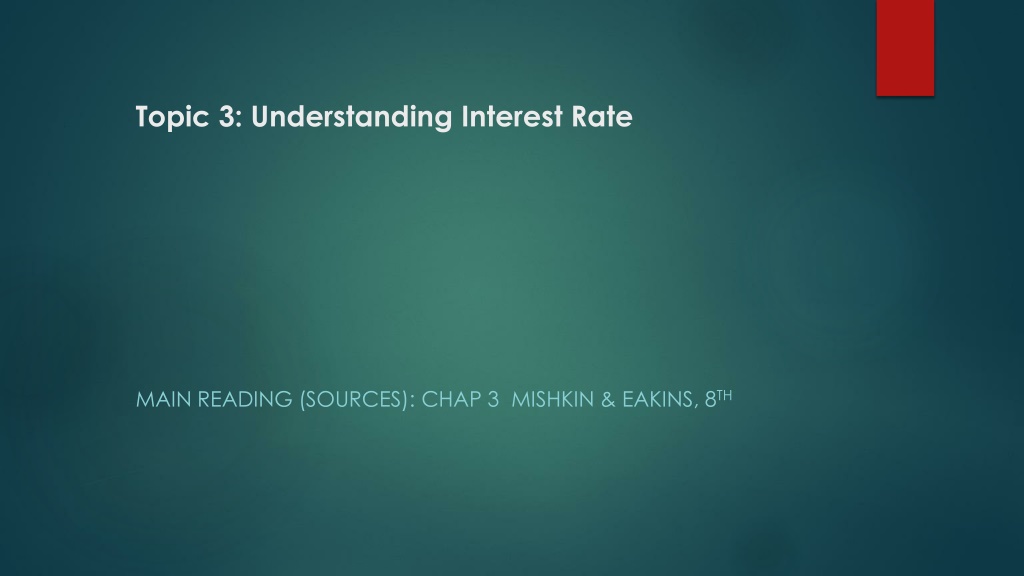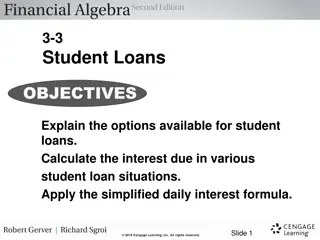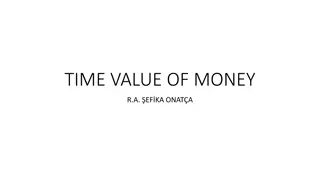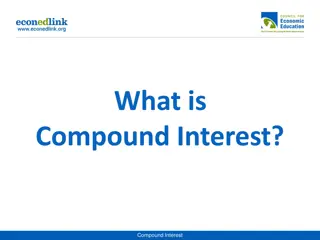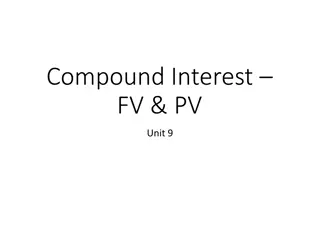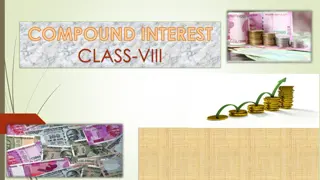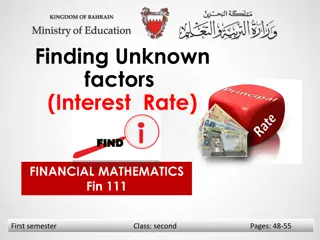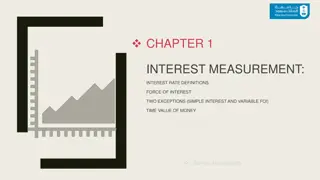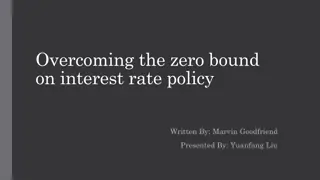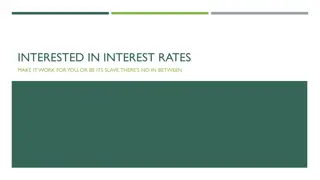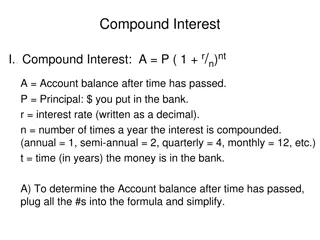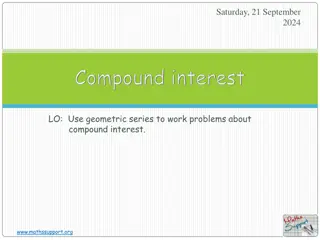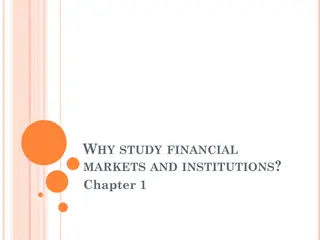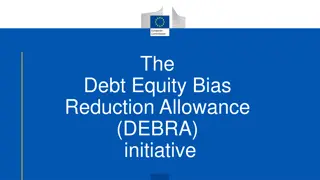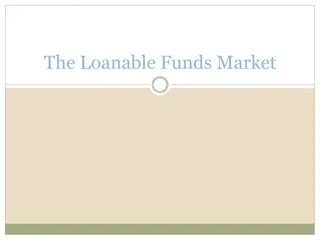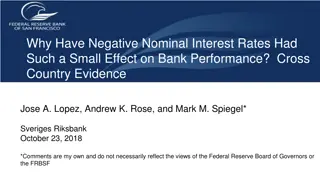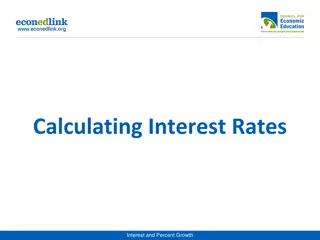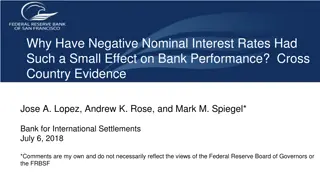Understanding Interest Rates: A Comprehensive Guide
Explore the terminology, calculation, and importance of various interest rates in our lives and the economy. Learn about measuring interest rates, real versus nominal rates, and the distinction between rates and returns. Dive into finance fields, debt concepts, time value of money, and investment variables.
Download Presentation

Please find below an Image/Link to download the presentation.
The content on the website is provided AS IS for your information and personal use only. It may not be sold, licensed, or shared on other websites without obtaining consent from the author. Download presentation by click this link. If you encounter any issues during the download, it is possible that the publisher has removed the file from their server.
E N D
Presentation Transcript
Topic 3: Understanding Interest Rate MAIN READING (SOURCES): CHAP 3 MISHKIN & EAKINS, 8TH
Chapter Preview In this chapter, we will develop a better understanding of interest rates. We examine the terminology and calculation of various rates, and we show the importance of these rates in our lives and the general economy. Topics include: Measuring Interest Rates The Distinction Between Real and Nominal Interest Rates The Distinction Between Interest Rates and Returns
Expected Value Line Growth (Return) EXIT Risk-Free Rate ENTRY Initial Investment
Expected Value Line Growth (Return) EXIT Risk Premium Risk-Free Rate ENTRY Initial Investment
Expected Value Line Growth (Return) EXIT Risk (Volatility) Risk Premium Risk-Free Rate ENTRY Initial Investment
The Study of Finance FIELDS OF FINACE Corporate Finance Investment Analysis Credit Analysis Risks that are pushing the Value Line down EXIT Risk (Volatility) Expected Value Line Growth (Return) Finance Strategies to Keep the Value Line Up Initial Investment ENTRY 3 FACTORS BEFORE YOU INVEST Measure Expected Return Quantify Risk Set Time (Exit)
Concepts -Terms of Debt (Loans and Bonds Money Terms Amount of Loan/Bond Interest Payment Maturity/Term Principal Payment (Original Loan/Bond Amount)
Concept- Time Value of Money 5 Variables Present Value (money you invest today, the amount loan you pay) Future Value (The expected money you will receive or pay in the future) Interest Rate Growth of your money Discount Rate Holding Period Return (HPR) Internal Rate of Return (IRR) or Rate of Return (ROR) Time Payment (Even Monthly, Even Annual Payment received or pay)
Measuring Interest Rate: Present Value Different debt instruments have very different streams of cash payments to the holder (known as cash flows), with very different timing. All else being equal, debt instruments are evaluated against one another based on the amount of each cash flow and the timing of each cash flow. This evaluation, where the analysis of the amount and timing of a debt instrument s cash flows lead to its yield to maturity or interest rate, is called present value analysis. Yield to maturity = interest rate that equates today s value with present value of all future payments
Present Value The concept of present value (or present discounted value) is based on the commonsense notion that a dollar of cash flow paid to you one year from now is less valuable to you than a dollar paid to you today. This notion is true because you could invest the dollar in a savings account that earns interest and have more than a dollar in one year. MONEY GROWS The term present value (PV) can be extended to mean the PV of a single cash flow or the sum of a sequence or group of cash flows.
Present Value There are four basic types of credit instruments which incorporate present value concepts: 1. Simple Loan 2. Fixed Payment Loan 3. Coupon Bond 4. Discount Bond
Present Value 1. Simple Loan Loan Principal: the amount of funds the lender provides to the borrower. Maturity Date: the date the loan must be repaid; the Loan Term is from initiation to maturity date. Interest Payment: the cash amount that the borrower must pay the lender for the use of the loan principal. Simple Interest Rate: the interest payment divided by the loan principal; the percentage of principal that must be paid as interest to the lender. Convention is to express on an annual basis, irrespective of the loan term.
Present Value Concept: Simple Loan (1 of 2) Simple loan of $100 Year: 0 1 2 3 n $100 $110 $121 133 100 (1+i)n Future Value: F=P (1+i)n Warren Buffett thought a haircut worth $300,000. Why? His company Berkshire Hathaway generated about 20% annual return in the 55 year period since 1965 until 2020. Suppose a fancy haircut cost $15, then future value of the hair-cut=15*(1+0.2)^55=?
Present Value Concept: Simple Loan (2 of 2) The previous example reinforces the concept that $100 today is preferable to $100 a year from now since today s $100 could be lent (or deposited) at 10% interest to be worth $110 one year from now, or $121 in two years or $133 in three years. You are just as happy having $100 today as having $110 a year from now, or as having $121 two years from now, or as having $133 three years from now.
Present Value Formula ?? ?+?? (1) ?? = (1) $1 ?? ?? ?????? ??? ?????? = 1 + ?? $110 1+0.11=$100 $121 1+0.12=$100 $133 1+0.13=$100 ?? ?? $110 ??? ???? ???? ??? = ?? ?? $121 ??? ???? ???? ??? = ?? ?? $133 ? ??? ???? ???? ??? =
Present Value: Example 3.1 Simple Present Value What is the present value of $250 to be paid in two years if the interest rate is 15%? CF=Cash flow in two years=$250 i=annual interest rate=0.15 n=number of years=2 ?? =?
Yield to Maturity: Loans Yield to maturity = interest rate that equates today s value with present value of all future payments Example: If Pete borrows $100 from his sister and next year she wants to $110 back from him, What is the yield to maturity on this loan? ?? ??? ? ? ??????? ?? = 1 + ?? $110 1 + ?1 100 = ? =?
Present Value Concept: Fixed- Payment Loan Terms Simple Loans require payment of one amount which equals the loan principal plus the interest. Fixed-PaymentLoans are loans where the loan principal and interest are repaid in several payments, often monthly, in equal dollar amounts over the loan term. Installment Loans, such as auto loans and home mortgages are frequently of the fixed-payment type.
Present Value Concept: Fixed- Payment Loan Terms 2. Fixed Payment Loan Suppose the loan is $1000 and the yearly cash flow payment is $85.81 for the next 25 years. $1000 =$85.81 (1 + ?)+$85.81 1 + ?2+$85.81 $85.81 1 + ?25 1 + ?3+ + n ?? (1+?)+ ?? 1+? ?? 1+? ?? 1+? ?=FP*1 1+? (2) ?? = 2+ 3+ + ? ?? = ??? ?? ?? ?? ??? ?????? ??????? Solving the equation, give us the yield to maturity of 7%.
Present Value Concept: Fixed- Payment Loan Terms Fixed Payment Loan 2. You will buy a new house and need a $100,000 mortgage. You take out a loan from the bank that has an interest rate of 7%. What is the yearly payment to the bank to pay off the loan in 20 years? ?? (1 + ?)+ ?? 1 + ?2+ ?? 1 + ?3+ + ?? ?? = 1 + ?? ?? ?? ?? ?? $100,000 = (1 + 0.07)+ 1 + 0.072+ 1 + 0.073+ + 1 + 0.0720 n ?? =FP*1 1+? ? Reverse it, we get ?? =LV* n ? 1 1+? Solving the equation, give us the yearly payment of $9439.29
Present Value Concept: Coupon Bond 3. Coupon Bond (Coupon rate = 10% = C/F) $100 (1 + ?)+ $100 1 + ?2+ $100 1 + ?3+ + $100 1 + ?10+ $1000 1 + ?10 ? = ? ? ? ? ? ? (3) ? = (1+?)+ 2+ 3+ + ?+ 1+? 1+? 1+? 1+? ? ? = C 1 1+? ? ? (3a) + ? 1+? Example 3.4: Find the price of a 10% coupon bond with a face value of $1,000, a 12.25% yield to maturity, and eight years to maturity. Solution: ? =?
Relationship Between Price and Yield to Maturity B C D E F G H I J H 2 MARKET PRICE 3 USING EXCEL FORMULAS TO CALCULATE PRICE 4 5 Face Value = 6 Settlement Date= 7 Maturity Date= 8 Coupon Rate= 9 Yield to Maturity= 10 Redemption value %= 11 Frequency (Coupon Pmts per year)= 12 13 Market Price (% Par) 14 15 16 17 18 19 20 It s also straight- forward to show that the value of a bond (price) and yield to maturity (YTM) are negatively related. If the interest rate i increases (YTM increases), the PV of any given cash flow is lower; hence, the price of the bond must be lower. USING EXCEL FORMULAS TO CALCULATE YIELD 1/15/2019 1/15/2024 4.250% 4.740% 1,000 Face Value = Settlement Date= Maturity Date= Coupon Rate= Price Redemption value %= Frequency (Coupon Pmts per year)= 1/15/2019 1/15/2024 4.250% 97.841 1,000 100 100 2 2 97.841 Yield to Maturity 4.740% =PRICE(D6,D7,D8,D9,D10,D11) =PRICE(SD,MD,CR,YTM,R,F) =YIELD(J6,J7,J8,J9,J10,J11) =YIELD(SD,MD,CR,PRICE,R,F)
Relationship Between Price and Yield to Maturity Table 3.1 Yields to Maturity on a 10% Coupon Rate Bond Maturing in 10 Years (Face Value = $1,000) Price of Bond($) 1,200 1,100 1,000 900 800 Yield to Maturity (%) 7.13 8.48 10.00 11.75 13.81 Three interesting facts in Table 3.1 When bond is at par, yield equals coupon rate 1. Price and yield are negatively related 2. Yield greater than coupon rate when bond price is below par value 3.
Present Value Concept: Coupon Bond 3. Coupon Bond Perpetuity or Consol: Fixed coupon payments of $C forever ? ??(5) ? ?? ??= ??= (4) Example 3.5: What is the yield to maturity on a bond that has a price of $2000 and pays $100 annually forever? Solution: ? ??= 100 20000= 0.05=5% ??=
Current Yield Current yield (CY) is just an approximation for YTM - easier to calculate. However, we should be aware of its properties: If a bond s price is near par and has a long maturity, then CY is a good approximation. 1. A change in the current yield always signals change in same direction as yield to maturity 2. Formula: ic = C / P
Present Value Concept: Discount Bond One-Year Discount Bond (Zero coupon bond) Consider one-year U.S. Treasury bill, P = $900, F = $1000 4. $900 =$1000 1 + ? ? =? For any one-year discount bond, the yield to maturity can be found by ? =? ? ? (6) ?? ?+?? For an N year zero bond, its price is ?? = (1) (1) For example: a two-year zero-coupon bond with face value of 1000 and the yield to maturity is 8 %. What is its price?
Distinction Between Real and Nominal Interest Rates (1 of 2) Nominal Interest Rate i =ir + e (7) Real interest rate Interest rate that is adjusted for expected changes in the price level 1. ir = i e (8) Real interest rate more accurately reflects true cost of borrowing 2. When the real rate is low, there are greater incentives to borrow and less to lend 3. We usually refer to this rate as the ex ante real rate of interest because it is adjusted for the expected level of inflation. After the fact, we can calculate the ex post real rate based on the observed level of inflation. 4.
Distinction Between Real and Nominal Interest Rates (2 of 2) If i = 5% and e = 0% then ??=5% 0% = 5% If i = 10% and e = 20% then ??=10% 20% = 10%
Global: Negative T-Bill Rates? It Can Happen In November 1998, rates on Japanese 6-month government bonds were negative! Investors were willing to pay more than they would receive in the future. Same thing happened in the U.S. in September of 2008, then Sweden (July 2009), Denmark (July 2012), the Eurozone (June 2014), Switzerland (December 2014), and Japan again in early 2016. Best explanation is that investors found the convenience of the Treasury bills (in the U.S. case) worth something more convenient than cash. But that can only go so far the rate was only slightly negative.
Figure 3.1 Real and Nominal Interest Rates (Three-Month Treasury Bill), 1953 2016 Sources: Federal Reserve Bank of St. Louis FRED database: https://fred.stlouisfed.org/series/TB3MS and https://fred.stlouisfed.org/series/CPIAUCSL. The real rate is constructed using the procedure outlined in Frederic S. Mishkin, The Real Interest Rate: An Empirical Investigation, Carnegie Rochester Conference Series on Public Policy 15 (1981): 151 200. This involves estimating expected inflation as a function of past interest rates, inflation, and time trends and then subtracting the expected inflation measure from the nominal interest rate.
Distinction Between Interest Rates and Returns Rate of Return: we can decompose returns into two pieces: ? =?+??+1 ?? ?? (9) Where ??=Current Yield= C/Pt , ? =Capital Gain Yield= (Pt+1 Pt)/Pt Example: What would the rate of return be on a bond bought for $1,000 and sold one year later for $800? Coupon=$1000*0.08=$80, Capital Gain=800-1000= -$200 Return=?? ? = ??+ ? (10)
Table 3.2 One-Year Returns on Different-Maturity 10% Coupon Rate Bonds When Interest Rates Rise from 10% to 20% Original maturity Initial Current Yield (%) Initial Price ($) Price Next Year ($) Rate of Capital Gain (%) Rate of Return (%) 30 10 1,000 503 49.7 39.7 20 10 1,000 516 48.4 38.4 10 10 1,000 597 40.3 30.3 5 10 1,000 741 25.9 15.9 2 10 1,000 917 8.3 1.7 1 10 1,000 1,000 0 10 Sample of current coupon rates and yields on government bonds http://www.bloomberg.com/markets/iyc.html
Maturity and the Volatility of Bond Returns (1 of 3) Key findings from Table 3.2 (1 of 2) Only bond whose return = yield is one with maturity = holding period 1. For bonds with maturity > holding period, as rates increase, price falls, implying capital loss 2. Longer is maturity, greater is price change associated with interest rate change 3.
Maturity and the Volatility of Bond Returns (2 of 3) Key findings from Table 3.2 (2 of 2) Longer is maturity, more return changes with change in interest rate 4. Bond with high initial interest rate can still have negative return if i 5.
Maturity and the Volatility of Bond Returns (3 of 3) Conclusion from Table 3.2 analysis Prices and returns more volatile for long-term bonds because they have higher interest-rate risk 1. No interest-rate risk for any bond whose maturity equals holding period 2.
Reinvestment Risk Occurs if investor holds a series of short bonds over long holding period i at which reinvest uncertain Gain from i , lose when i
Formula for Duration ??? 1+? ??? 1+? ? (11) ? ? ??? = ?=1 ?/ ?=1 ? Key facts about duration All else equal, when the maturity of a bond lengthens, the duration rises as well All else equal, when interest rates rise, the duration of a coupon bond fall 3. The higher the coupon rate on the bond, the shorter the duration of the bond 4. Duration is additive: the duration of a portfolio of securities is the weighted-average of the durations of the individual securities, with the weights equaling the proportion of the portfolio invested in each security 1. 2.
Table 3.3 Calculating Duration on a $1,000 Ten-Year 10% Coupon Bond When Its Interest Rate Is 10% (1) Year (2) (3) (4) (5) Cash Payments (Zero-Coupon Bonds) ($) 100 100 100 100 100 100 100 100 100 100 1,000 Blank Present Value (PV) of Cash Payments (i = 10%) ($) 90.91 82.64 75.13 68.30 62.09 56.44 51.32 46.65 42.41 38.55 385.54 1,000.00 Weights (% of total PV = PV/$1,000) (%) Weighted Maturity (1 4)/100 (years) 1 2 3 4 5 6 7 8 9 10 10 9.091 8.264 7.513 6.830 6.209 5.644 5.132 4.665 4.241 3.855 38.554 100.000 0.09091 0.16528 0.22539 0.27320 0.31045 0.33864 0.35924 0.37320 0.38169 0.38550 3.85500 6.75850 Total
Table 3.4 Calculating Duration on a $1,000 Ten-Year 10% Coupon Bond When Its Interest Rate Is 20% (1) Year (2) (3) (4) (5) Cash Payments (Zero-Coupon Bonds) ($) 100 100 100 100 100 100 100 100 100 100 1,000 Blank Present Value (PV) of Cash Payments (i = 20%) ($) 83.33 69.44 57.87 48.23 40.19 33.49 27.91 23.26 19.38 16.15 161.51 580.76 Weights (% of total PV = PV /$580.76) (%) 14.348 11.957 9.965 8.305 6.920 5.767 4.806 4.005 3.337 2.781 27.808 100.000 Weighted Maturity (1 4)/100 (years) 1 2 3 4 5 6 7 8 9 10 10 0.14348 0.23914 0.29895 0.33220 0.34600 0.34602 0.33642 0.32040 0.30033 0.27810 2.78100 5.72204 Total
Duration and Interest-Rate Risk (1 of 2) Duration can be used to show that the approximate change in price is related to duration, as follows: ? 1 + ? (12) i 10% to 11%: Table 3.4, 10% coupon bond % Price = 6.76 (0.01 / 1.10) = 6.15% % Price = DUR i 10% to 11%: 20% coupon bond, DUR = 5.72 years % Price = ????
Duration and Interest-Rate Risk (2 of 2) The greater the duration of a security, the greater the percentage change in the market value of the security for a given change in interest rates Therefore, the greater the duration of a security, the greater its interest-rate risk
Chapter Summary Measuring Interest Rates: We examined several techniques for measuring the interest rate required on debt instruments. The Distinction Between Real and Nominal Interest Rates: We examined the meaning of interest in the context of price inflation. The Distinction Between Interest Rates and Returns: We examined what each means and how they should be viewed for asset valuation.
One-Time Investment FUTURE VALUE FV = PV 1 + it where FV is the future value of the investment, PV is the present value of the investment or the initial investment, i is the expected interest rate or rate of return of the investment, and t is time to realize such investment. PRESENT VALUE FV 1+it FV = PV 1 + it, then PV = As an example, assuming the investor targets an investment that is expected to receive $133.10 in 3 years, representing a 10% interest or expected return (sometimes referred to as the discount rate), the investment required today will be calculated as follows: FV 1+it = 133.10 1+.103 = 133.10 1.331= 100 PV =
One-Time Investment INTEREST RATES If the investor knows the amount they are planning to invest today, and targets a specific investment payoff at a set time in the future, then the investor can rearrange the formula to calculate the interest (i) or discount rate that he or she will earn, as follows: Starting at FV = PV 1 + it, then 1 + it=FV PV , and 1 ? 1 i = (?? ??) As an example, let s assume the investor invests $100 today and targets an investment that expects to receive $133.10 in 3 years. What will the annual rate of return be on such an investment? 1 ? 1 = (133.10 1 3 1 = (1.331) 1 3 1 = 1.10 1 = 0.10 = 10% i = (?? ??) 100)
One-Time Investment TIME If the investor knows the amount that they are planning to invest today, then sets a target payoff amount in the future and assumes a given rate of return, then he or she can calculate how long it will take to achieve the target. The time (t) to realize the targeted return is calculated by rearranging the formula as follows: FV PV, then adding ln on both sides, you get ln 1 + it= ln(FV Starting at FV = PV 1 + it, then 1 + it= PV) , ? [ln 1 + ? ] = ln(FV ?? (?? PV) , and ??) t = ??(1+?) As an example, assume the investor invests $100 today and wants to find out how long it will take for the investment to reach $133.10 if invested at an annual rate of return of 10%. The time to reach the targeted future value of such investment is calculated as follows: ?? (?? ??(1+?)= ?? (133.10 ??(1+0.10)= ?? (133.10 ??(1+0.10)= ??) 100) 100) ?? (1.331) ??(1.100)= 0.2859 0.0953= 3 years t =
Uneven Annual Cash Flows If the investment expected to produce uneven annual cash flows to the investor, called payments, for a set time, using the same expected rate of return, then the investment is calculated differently. The present value of such cash flows is the sum of all the future cash flows discounted back at a given expected rate of return, as follows: ??1 (1+?)1+ ??2 (1+?)2+ ??3 (1+?)3+ ??? 1+?? .?? = ??? (1+?)? PV = For example, if an investor expects to receive $95 the first year, $92 the second year, and $105 the third year, what is the present value for such an investment if the investor expects a 10% annual rate of return? The calculation of the present value of such investment is as follows: ??1 (1+?)1+ ??2 (1+?)2+ ??3 (1+?)3= 95 92 105 PV = (1+0.10)1+ (1+1.10)2+ (1+1.10)3= 86.36 + 76.03 + 78.89 = 241.28
Excel based formulas: Excel formulas for calculating all five variables including the present value, future value, rate of return, time and cash flows or payments (represent set additional payments received during the investment): = PV (rate, years, payment, future value) or =pv(rate,nper,pmt,fv) =FV (rate, years, payment, -present value) or =fv(rate,nper,pmt,pv) =Rate (years, payment, - present value, future value) or =rate(nper,pmt,pv,fv) =Nper (rate, payment, - present value, future value) or =nper(rate,pmt,pv,fv) = Pmt (rate, years, -present value, future value) or =pmt(rate,nper,pv,fv)
